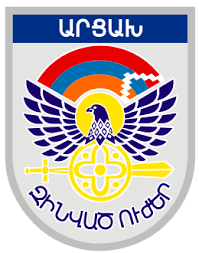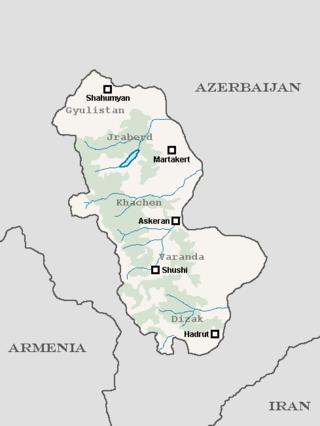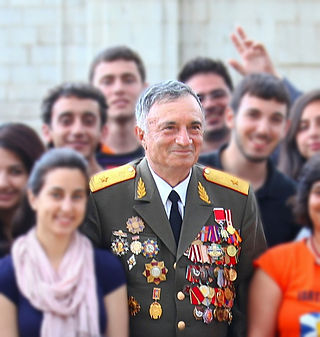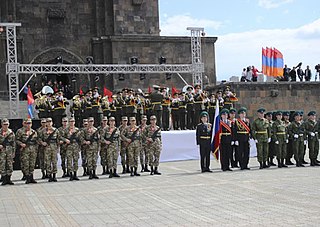This article needs additional citations for verification .(February 2024) |
The military history of the Republic of Artsakh contains information about the history of military actions or events performed by or in the Republic of Artsakh.
This article needs additional citations for verification .(February 2024) |
The military history of the Republic of Artsakh contains information about the history of military actions or events performed by or in the Republic of Artsakh.
The Artsakh Defense Army (sometimes also known as Artsakh Self-Defense Army) was officially established on May 9, 1992 as the formal defense force of the unrecognized Republic of Artsakh, uniting previously disorganized self-defense units which were formed in the early 1990s in order to protect the ethnic Armenian population of Artsakh from the attacks by the military of the Soviet and Azerbaijani forces. Currently Artsakh Defence Army is around 15,000–20,000 well-trained and equipped officers and soldiers. It consists of infantry, tanks, artillery and anti-aircraft systems.
The Capture of Shushi marked the first significant military victory by Armenian forces in the Nagorno-Karabakh enclave during the First Nagorno-Karabakh War . The battle was part of a larger territorial land dispute with the predominantly Armenian population in Karabakh who, aided by the neighboring Armenia, regained independence from the Republic of Azerbaijan. The battle took place in the strategically vital mountain town of Shusha (known as Shushi to Armenians) on the evening of May 8, 1992 and fighting swiftly concluded the following day after Armenian forces captured and drove out the defending Azeris. Armenian military commanders based in Nagorno-Karabakh's capital of Stepanakert had been contemplating the seizure of the town after a hail of Azeri military bombardment had begun shelling the city. [1]
The Battle of Kelbajar was the capture of the western region of Kelbajar, Azerbaijan during the 1993 spring-summer campaign by Armenian military forces in the First Nagorno-Karabakh War . [2] Kelbajar was outside the boundaries of the contested enclave of Nagorno-Karabakh that Armenian and Azeri forces had been fighting over for five years. Bordering Armenia proper, the predominantly Armenian populated region of Nagorno-Karabakh had announced their declaration of independence from Azerbaijan in 1991 and fighting had taken place mostly in the enclave itself. Seeking to keep the territory under its rule, the Armenians of Karabakh were aided by Armenia itself in the form of logistics, supplies, volunteers and military weaponry. Kelbajar, only several kilometers from Armenia's border, comprised several dozen villages including its eponymous provincial capital.
The First Nagorno-Karabakh War refers to the armed conflict that took place from February 1988 to May 1994, in the small ethnic enclave of Nagorno-Karabakh in southwestern Azerbaijan, between the ethnic Armenians of Nagorno Karabakh backed by Armenia and Azerbaijani Republic. [3] As the war progressed, Armenia and Azerbaijan, both former Soviet Republics, became enveloped in a protracted, undeclared war as the latter attempted to curb a secessionist movement in Nagorno-Karabakh. The enclave's parliament had voted in favor of uniting itself with Armenia and a referendum was held with the vast majority of the Karabakh population voting in favor of independence. The demand to unify with Armenia, which proliferated in the late 1980s, began in a relatively peaceful manner; however, in the following months, as the Soviet Union's disintegration neared, it gradually grew into an increasingly violent conflict between the two ethnic groups.
The Artsakh Defence Army suffered a defeat in the 2020 Nagorno-Karabakh war, fighting against the military of Azerbaijan.

Nagorno-Karabakh is a region in Azerbaijan, covering the southeastern stretch of the Lesser Caucasus mountain range. Part of the greater region of Karabakh, it spans the area between Lower Karabakh and Syunik. Its terrain mostly consists of mountains and forestland.

Artsakh, officially the Republic of Artsakh or the Republic of Nagorno-Karabakh, was a breakaway state in the South Caucasus whose territory was internationally recognised as part of Azerbaijan. Between 1991 and 2023, Artsakh controlled parts of the former Nagorno-Karabakh Autonomous Oblast of the Azerbaijani Soviet Socialist Republic, including its capital Stepanakert. It had been an enclave within Azerbaijan from the 2020 Nagorno-Karabakh war until the 2023 Azerbaijani offensive, when the Azerbaijani military took control over the remaining territory controlled by Artsakh. Its only overland access route to Armenia after the 2020 war was via the 5 km (3.1 mi) wide Lachin corridor, which was placed under the supervision of Russian peacekeeping forces.

The First Nagorno-Karabakh War was an ethnic and territorial conflict that took place from February 1988 to May 1994, in the enclave of Nagorno-Karabakh in southwestern Azerbaijan, between the majority ethnic Armenians of Nagorno-Karabakh backed by Armenia, and the Republic of Azerbaijan with support from Turkey. As the war progressed, Armenia and Azerbaijan, both former Soviet republics, entangled themselves in protracted, undeclared mountain warfare in the mountainous heights of Karabakh as Azerbaijan attempted to curb the secessionist movement in Nagorno-Karabakh.

The Artsakh Defence Army was the defence force of the breakaway Republic of Artsakh. Established in 1992, it united previously disorganized defence units which were formed in the early 1990s.

The Nagorno-Karabakh conflict was an ethnic and territorial conflict between Armenia and Azerbaijan over the region of Nagorno-Karabakh, inhabited mostly by ethnic Armenians until 2023, and seven surrounding districts, inhabited mostly by Azerbaijanis until their expulsion during the 1990s. The Nagorno-Karabakh region was entirely claimed by and partially controlled by the breakaway Republic of Artsakh, but was recognized internationally as part of Azerbaijan. Azerbaijan gradually re-established control over Nagorno-Karabakh region and the seven surrounding districts.
Nagorno-Karabakh is located in the southern part of the Lesser Caucasus range, at the eastern edge of the Armenian Highlands, encompassing the highland part of the wider geographical region known as Karabakh. Under Russian and Soviet rule, the region came to be known as Nagorno-Karabakh, meaning "Mountainous Karabakh" in Russian. The name Karabakh itself was first encountered in Georgian and Persian sources from the 13th and 14th centuries to refer to lowlands between the Kura and Aras rivers and the adjacent mountainous territory.

The Karabakh Council was the unrecognised government over Mountainous Karabakh (Nagorno-Karabakh) in eastern Armenia between 1918 and 1920. The council's body was elected by the assembly of Mountainous Karabakh—the representative body of the people of Nagorno-Karabakh—on 27 July 1918. Initially it was called the People's Government of Karabakh, but in September 1918 it was renamed into the Karabakh Council. The Karabakh Council's control throughout 1918–1920 did not exceed the ethnic Armenian locales of Karabakh which were subordinate to them. The council's statehood related to the historical Artsakh province and the modern-day self-proclaimed Republic of Artsakh founded in 1991. Its capital was the city of Shushi (Shusha).

The Battle of Shusha was the first significant military victory by Armenian forces during the First Nagorno-Karabakh War. The battle took place in the strategically important mountain town of Shusha on the evening of 8 May 1992, and fighting swiftly concluded the next day after Armenian forces captured it and drove out the defending Azerbaijanis. Armenian military commanders based in Nagorno-Karabakh's capital of Stepanakert had been contemplating capturing the town after Azerbaijani shelling of Stepanakert from Shusha for half a year had led to hundreds of Armenian civilian casualties and mass destruction in Stepanakert.
The Battle of Kalbajar took place in March and April 1993, during the First Nagorno-Karabakh War. It resulted in the capture of the Kalbajar District of Azerbaijan by Armenian military forces.

Arkady Ivani Ter-Tadevosyan, also known by his nom-de-guerre Komandos, was a Soviet and Armenian Major General, a military leader of the Armenian forces during the First Nagorno-Karabakh War and Armenia's former Deputy Minister of Defense. Ter-Tadevosyan is best known as the commander of the operation to capture the town of Shushi on 8–9 May 1992.

Seyran Musheghi Ohanyan is an Armenian general and politician currently serving as a deputy in the National Assembly of Armenia. He served as Defence Minister of Armenia from 14 April 2008 until 3 October 2016. A native of Nagorno-Karabakh, he participated in both the first and second Karabakh wars, and from 2000 to 2007 served as defence minister of the unrecognized Republic of Artsakh.

United Nations Security Council resolution 822 was adopted unanimously on 30 April 1993. After expressing concern at the deterioration of relations between Armenia and Azerbaijan, and the subsequent escalation of armed hostilities and deterioration in the humanitarian situation in the region, the Council demanded the immediate cessation of hostilities and the immediate withdrawal of Armenian occupying forces in the Kalbajar district near Nagorno-Karabakh in Azerbaijan.

The 2008 Mardakert clashes began on March 4 after the 2008 Armenian election protests. It involved the heaviest fighting between ethnic Armenian and Azerbaijani forces over the disputed region of Nagorno-Karabakh since the 1994 ceasefire after the First Nagorno-Karabakh War.

Dashalty or Karin Tak is a village in the Shusha District of Azerbaijan, in the region of Nagorno-Karabakh. Until 2024, the village was controlled by the Republic of Artsakh. The village had an ethnic Armenian-majority population prior to the 2020 Nagorno-Karabakh war, and also had an Armenian majority in 1989.

Demographic features of the population of Artsakh include population density, ethnicity, education level, health of the populace, economic status, religious affiliations, and other aspects.

The Armenian-occupied territories surrounding Nagorno-Karabakh were areas of Azerbaijan, situated around the former Nagorno-Karabakh Autonomous Oblast (NKAO), which were occupied by the ethnic Armenian military forces of the breakaway Republic of Artsakh with military support from Armenia, from the end of the First Nagorno-Karabakh War (1988–1994) to 2020, when the territories were returned to Azerbaijani control by military force or handed over in accordance to the 2020 Nagorno-Karabakh ceasefire agreement. The surrounding regions were seized by Armenians under the justification of a "security belt" which was to be traded for recognition of autonomous status from Azerbaijan.

The siege of Stepanakert started in late 1991, during the First Nagorno-Karabakh War, in Stepanakert, the largest city in Nagorno-Karabakh, when the Azerbaijani forces circled the city. Until May 1992, the city and its Armenian population were the target of a months-long campaign of bombardment by Azerbaijan. The bombardment of Stepanakert and adjacent Armenian towns and villages, which took place under the conditions of total blockade by Azerbaijan, caused widespread destruction and many civilian deaths.

The Karabakh movement, also known as the Artsakh movement, was a national mass movement in Armenia and Nagorno-Karabakh from 1988 to 1991 that advocated for the transfer of the mainly Armenian-populated Nagorno-Karabakh Autonomous Oblast of neighboring Azerbaijan to the jurisdiction of Armenia.

Shushi Liberation Day is a national holiday celebrated in Armenia and formerly in the self-proclaimed Republic of Artsakh. It is commemorated on both 8 and 9 May as a way to celebrate the anniversary of the Capture of Shushi and the Siege of Stepanakert from Azerbaijani forces in 1992. Being both former Soviet republics, the holiday also commemorates the traditional Victory Day celebrations on 9 May, commemorating the surrender of Nazi Germany at the end of the Great Patriotic War in 1945. The holiday serves as the official holiday of the Artsakh Defense Army, which was established on this day.

The Battle of Shusha was the final and decisive battle of the Second Nagorno-Karabakh War, fought between the armed forces of Azerbaijan and the self-proclaimed Republic of Artsakh, militarily supported by Armenia, over the control of the city of Shusha. The battle is considered one of the bloodiest battles of the war.
The mostly Armenian population of the disputed region now lives under the control of the Nagorno-Karabakh Republic, a micronation that is supported by Armenia and is effectively part of that country.